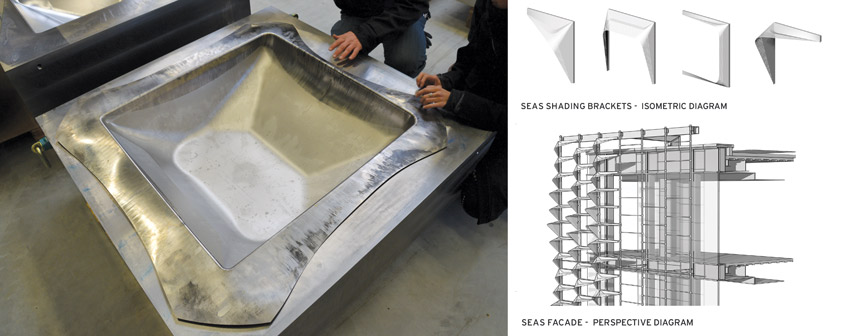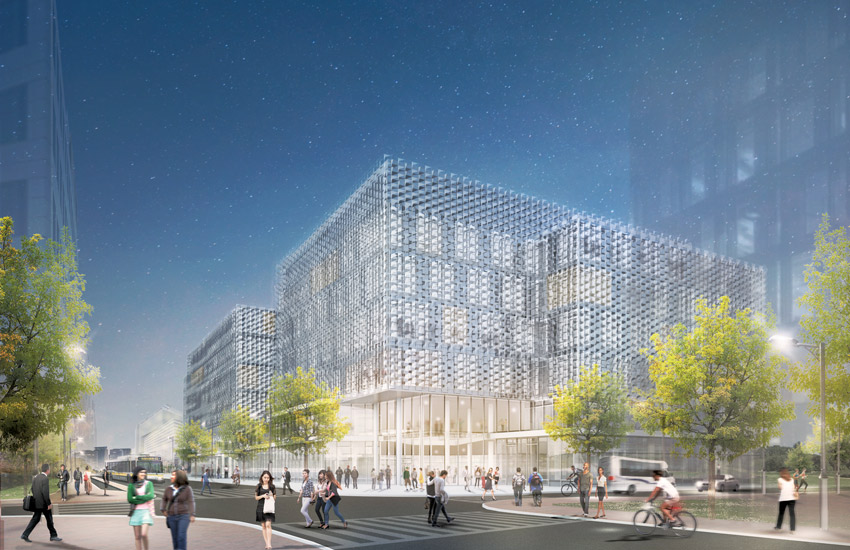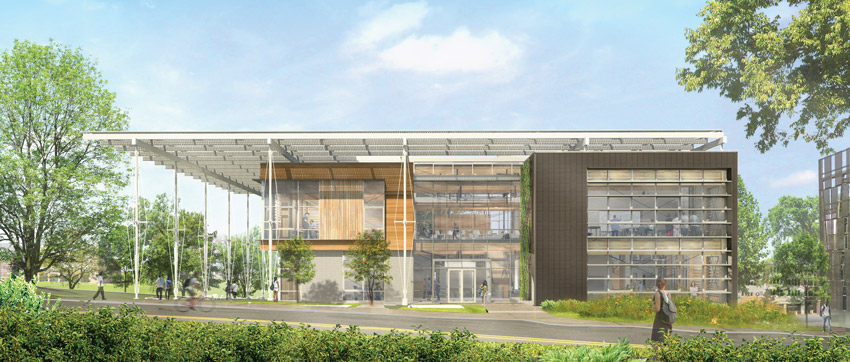Building-Integrated Shading
Beyond Sun Block: Innovative shading solutions not only provide protection but further architectural expression.
![]() Continuing Education
Continuing Education
Use the following learning objectives to focus your study while reading this month’s Continuing Education article.
Learning Objectives - After reading this article, you will be able to:
- Discuss shading strategies that can strengthen a building’s architectural identity.
- Explain how the shading schemes discussed in the article help save energy while maintaining occupant comfort.
- Describe the modeling, simulation, and analyses that helped produce each of these shading schemes.
- Define technical terms relevant to shading, such as “SCC” and “insolation.”
View course on architecturalrecord.com »
By the time solar radiation hits an interior blind, the fight to save energy has been lost. The great advantage of exterior shading devices is that they block the heat outside, before it can penetrate the building envelope. Depending on their design, they can also improve daylighting by reducing glare and bouncing indirect light deep into interior spaces. They can even strengthen a building’s identity. But North American construction culture has been slower than that of many other countries to embrace exterior shades.


IMAGES: © BEN RAHN/A-FRAME (TOP AND BOTTOM LEFT); COURTESY HARIRI PONTARINI ARCHITECTS (BOTTOM RIGHT)
ALL WRAPPED UP
The renovated Jackman Law Building (top) is animated by vertical shade fins. Within the reading room (bottom left), the fins are continued as white-painted pilasters that act as vertical light shelves.
From the 1990s until quite recently, architects on this continent often envied the textured and articulated building envelopes their international counterparts were creating, while their own shade designs were regularly stripped in cost-cutting rounds. As energy conservation has become a top priority, however, and integrated design teams with access to increasingly sophisticated modeling tools are able to quantify the benefits of shade, those sad old days are receding. Building envelopes in North America are now incorporating shading that is as inventive and expressive as anything architects here might once have envied.
Exterior shades’ best chance of surviving the process euphemistically known as value engineering is to serve more than one goal. The Jackman Law Building, by Toronto-based Hariri Pontarini Architects (HPA) and B+H Architects; the John A. Paulson of Engineering and Applied Sciences, by the Boston office of Behnisch Architekten; and the Kendeda Building for Innovative Sustainable Design, by Lord Aeck Sargent (Atlanta) in collaboration with the Miller Hull Partnership (Seattle), exemplify a new generation of shading-integrated exterior envelopes that do more than keep their cool.
For the Jackman Law Building, a 2016 renovation and addition to the University of Toronto’s Faculty of Law, the challenge was to unify the school’s disparate and organizationally disjointed pieces, built over a span of nine decades, and to give it a physical expression commensurate with its institutional significance. The brief included recladding and renovating a library, and creating new classrooms, offices, and gathering space. Says Siamak Hariri, principal at HPA, “The need for shading gave us a way in, to do something that gives an order and a presence to the entire building.”
Located on a prominent site with five major frontages, the irregular building’s new and renovated parts are wrapped in a simple rhythm of vertical shade fins. (Because the building has almost no exposure due south, vertical shades are an effective solution.) Executed in local limestone, the fins make multiple references, from the columns supporting the portico of the school’s neoclassical main facade, built in 1902, to similar fins on the courthouse a few blocks south, and, metaphorically, to the pillars of justice.
In response to client concerns about whether the fins would block too much light, HPA conducted comprehensive daylight studies. The architect relied primarily on physical models, supplementing them with digital simulations, to prove the concept to their clients and to themselves. The fins’ 2-foot depth and 5-foot-on-center spacing is informed by these analyses—and by the need for an office-friendly module—as is the 18-inch depth of white-painted pilasters on the library interior. The latter act as vertical light shelves, mitigating glare and reflecting light more deeply into the space.
The choice of stone for the shade fins stems from an aspiration to counter a look of mindless mediocrity that Hariri sees being inflicted on cities by the widespread use of ersatz materials. Imitations lack the dignity, patina, and subtle variety of natural materials, he says, and he advocates for beauty as a value in its own right, as well as for its contribution to durability: “A really good building is one that people will not let be taken down.”
There’s still the immediate reality of cost, however, and the project budget of $42 million had no room for extras. Working closely with the supplier, HPA designed a shop-fabricated assembly that brought stone into the price range of its precast-concrete competitor. The fins are built up with straight sections of limestone clipped to a steel armature that is suspended from the slab edge (with careful detailing to mitigate thermal bridging). Rather than appearing as solid, which the natural variety of the panels precludes anyway, the fins are designed to express their assembly, with reveals at panel joints. The underside of the armature is closed with a bronze metal plate, and the section of the stone cladding is visible from the street below.
Within the shade fins’ uniform rhythm, the thermal envelope syncopates in response to the programmatic requirements and the facade’s different exposures. A play of glass and metal cladding balances the wall-to-window ratio for energy performance, and the double-glazed units incorporate their own type of shade with a spectrally selective coating. (SCC reflects the infrared, or heat, segment of the solar spectrum while admitting a higher portion of visible light.) The SCC on the interior surface of the outboard lite has a bronze tint to complement the stone, while a low-E coating on the exterior surface of the clear inboard lite further improves the glazing’s ability to shield against solar gains.


IMAGES: COURTESY BEHNISCH ARCHITEKTEN
LACE VEIL
At Harvard University’s SEAS (bottom), a textured screen of 48,000 hydroformed stainless-steel brackets (top left) will dissolve the large building’s apparent mass.
Where the Jackman project leverages a shading requirement to bring identity and gravitas to what was previously a motley cluster of volumes, the six-story, 497,000-square-foot Paulson School of Engineering and Applied Science (SEAS), a teaching and research complex under construction at Harvard University’s Allston campus, uses a shade structure to dissolve a single large building’s apparent mass. “The challenge of the SEAS was its sheer size,” says Matt Noblett, a partner at Behnisch. “We were looking for ways to disguise typical visual clues to scale, and shading helped us achieve that.”
Building on the firm’s recent work with fixed-shade wraps on the AGORA Cancer Research Center in Lausanne, Switzerland, and the Adidas headquarters expansion in Herzogenaurach, Germany—and bearing in mind what Noblett characterizes as the U.S. market’s “skittish” response to operable shading devices—the architect focused on developing a system of fixed elements. The goal was to achieve the effective coverage of an active system, but without the maintenance associated with moving parts.
After breaking the program into three smaller (but still big) volumes, and perching them on a glassy base, the design team deployed a textured shade veil to prevent windows from telegraphing the upper volumes’ scale while maintaining occupants’ quality of daylight and views. The veil consists of a lattice of stainless-steel brackets shaped to optimize sun protection for each orientation. The modular brackets, 2½ feet square, affix to a laddered framework, which in turn fastens to the steel mullions of the curtain wall. Behind the lattice, a weather envelope of glass comprises clear and opaque units. The latter, which account for every third panel and include insulation, strengthen the building’s thermal performance; staggered from floor to floor, they also contribute to the facade’s pattern.
On south-facing elevations, cowl-shaped brackets block overhead summer sun and provide ancillary side protection against morning and afternoon sun angles. On east- and west-facing elevations, L-shaped shades protect against low sun angles. And on the nominal north (actually northwest), a slender, C-shaped visor provides protection on summer afternoons. In addition to these orientation-specific types, three or four variations within each facade add complexity to the texture.
To mitigate potential glare from a high contrast between the shades’ undersides and a bright sky, the shades are perforated to create a zone of intermediate brightness. This dissolving of the bracket edges also reiterates at the aperture scale the idea of dematerialization that gave rise to the veil in the first place.
The 48,000 shades are fabricated in Germany using hydroforming technology, a process common in automobile manufacture but rare in architecture. For each of the 14 unique shade shapes, a 3-foot-3-inch-square stainless-steel block is milled with a CNC (computer numerically controlled) machine to create a negative. A 1/16-inch thick sheet of steel is placed between the negative and a top mold, with water injected to press the sheet precisely into the form. A five-axis laser then trims the excess and perforates the edges. Advantages of the technology include the brackets’ fluid forms, their geometric precision, and their light weight—with consequent cost savings in the support structure compared to welded options.
The effectiveness of the SEAS’s shade veil enables the project to rely on low-energy environmental controls, including passive ventilation, chilled beams, and radiant slabs, with more intensive cooling, dehumidification, and ventilation in areas, such as labs, where these are specifically required.
The ability to rely on low-energy environmental controls is even more crucial for Georgia Tech’s Kendeda Building for Innovative Sustainable Design, which is targeting Living Building Challenge (LBC) certification. In order to attain this status, the two-story, hybrid mass-timber structure, scheduled for completion in 2019, will have to satisfy a number of stringent requirements. One of the more difficult will be keeping occupants comfortable in Atlanta’s heat and humidity while using no more electricity than the project itself can generate.
“In a perfect world, an east–west orientation would help control heat gain, harvest daylight, and create a high-performance building,” says Joshua Gassman, sustainable-design director at Lord Aeck Sargent. But other siting factors, such as connecting to campus open space and circulation paths, took priority. “We ended up with a design strategy where the building is oriented the ‘wrong’ way,” says Gassman, “with a large west-facing facade.”
To maintain occupant comfort within the capacity of Kendeda’s super-low-energy systems, the design team began with the notion of comfort itself, using the on-line Thermal Comfort Tool from the Center for the Built Environment at the University of California, Berkeley, to play with variables, and Georgia Tech’s environmental testing chamber to understand the role of humidity. Working with the parameters from these investigations, the team performed extensive modeling to optimize the window-to-wall ratio, the glazing specifications, and shading to keep cooling loads within the energy that the building’s photovoltaic (PV) array could supply.
Kendeda’s big shading move draws on the architects’ studies of regional and international vernacular examples for hot, humid climates. Reinterpreting the traditional front porch, which creates both shade and a connective social space, the 455,000-kWh-per-year rooftop PV grid is shifted west to create a 5,900-square-foot west overhang. This porch completely solves the west shading for the second story (with additional overhang helping the south), expands the water-collection surface to meet the LBC’s net-positive water requirement, and creates sheltered teaching and gathering spaces adjacent to the building.


IMAGES: COURTESY LORD AECK SARGENT, THE MILLER HULL PARTNERSHIP, AND PAE ENGINEERS (BOTTOM); LORD AECK SARGENT AND THE MILLER HULL PARTNERSHIP (TOP)
PHOTOVOLTAIC PARASOL
A rooftop PV array will shade Kendeda’s second story. Motorized exterior blinds will protect the first floor until trees grow in (bottom). The PVs will also help shade the south facade (top).
On the ground floor, however, the porch leaves some of the west facade exposed to summer insolation. (Not to be confused with insulation, insolation is the amount of solar radiation reaching a given area in a given unit of time.) In the long term, a row of trees will provide seasonal shade and contribute to the vitality of the gathering spaces. For the shorter term, until the new trees fill out, the design team evaluated options for fixed exterior shading around the porch, but issues such as head clearance, lack of visual openness, loss of daylight, and increased wind loads made these options less than ideal for the circumstance. Instead, the west facade—and the east, where there’s no room for overhead shade—will use motorized and automated exterior blinds of clear anodized aluminum.
The clients did not immediately warm to the active-shade proposal. In fact, “they were adamantly against it,” says Gassman. But the energy analysis, combined with reassurance from the building manager at the LBC-certified Bullitt Center, which Miller Hull designed in Seattle, and which now has several years’ trouble-free experience with active shading, convinced them in the end.
Gassman describes the quest to integrate the Kendeda Building’s conservation strategies into a balanced whole—shading among them—as a four-dimensional puzzle, with the element of time as the fourth dimension. He quotes naturalist and conservationist John Muir: “When we try to pick out anything by itself, we find it hitched to everything else.” For this project, as for the SEAS and the Jackman Building, a holistic approach to shade design—hitching it to multiple priorities—generated vigorous, multifaceted solutions that are integral to their projects’ architecture.
Katharine Logan is a designer and writer focusing on architecture, sustainability, and well-being.
